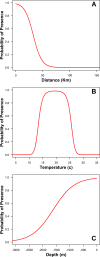Quantifying habitat selection and variability in habitat suitability for juvenile white sharks
- PMID: 31067227
- PMCID: PMC6505937
- DOI: 10.1371/journal.pone.0214642
Quantifying habitat selection and variability in habitat suitability for juvenile white sharks
Abstract
While adult white sharks (Carcharodon carcharias) are apex predators with a circumglobal distribution, juvenile white sharks (JWS) feed primarily on bottom dwelling fishes and tend to be coastally associated. Despite the assumedly easier access to juveniles compared to large, migratory adults, limited information is available on the movements, environments, and distributions of individuals during this life stage. To quantify movement and understand their distribution in the southern California Bight, JWS were captured and fitted with dorsal fin-mounted satellite transmitters (SPOT tags; n = 18). Nine individuals crossed the U.S. border into Baja California, Mexico. Individuals used shallow habitats (134.96 ± 191.1 m) close to shore (7.16 ± 5.65 km). A generalized linear model with a binomial distribution was used to predict the presence of individuals based on several environmental predictors from these areas. Juveniles were found to select shallow habitats (< 1000 m deep) close to land (< 30 km of the shoreline) in waters ranging from 14 to 24°C. Southern California was found to be suitable eight months of the year, while coastal habitats in Baja California were suitable year-round. The model predicted seasonal movement with sharks moving from southern California to Baja California during winter. Additionally, habitat distribution changed inter-annually with sharks having a more northerly distribution during years with a higher Pacific Decadal Oscillation index, suggesting sharks may forego their annual fall migrations to Baja California, Mexico, during El Niño years. Model predictions aligned with fishery-dependent catch data, with a greater number of sharks being captured during periods and/or areas of increased habitat suitability. Thus, habitat models could be useful for predicting the presence of JWS in other areas, and can be used as a tool for potentially reducing fishery interactions during seasons and locations where there is increased susceptibility of incidental catch.
Conflict of interest statement
The authors have declared that no competing interests exist.
Figures






References
-
- Levings SC (1983) Seasonal, Annual, and Among‐site Variation in the Ground Ant Community of a Deciduous Tropical Forest: Some Causes of Patchy Species Distributions. Ecological Monographs 53: 435–455.
-
- Bailey H, Benson SR, Shillinger GL, Bograd SJ, Dutton PH, Eckert SA, et al. (2012) Identification of distinct movement patterns in Pacific leatherback turtle populations influenced by ocean conditions. Ecological Applications 22: 735–747. - PubMed
-
- Nicolson C, Berman M, West C, Kofinas G, Griffith B, Russel D, et al. (2013) Seasonal climate variation and caribou availability: modeling sequential movement using satellite-relocation data. Ecology and Society 18.
Publication types
MeSH terms
LinkOut - more resources
Full Text Sources
Miscellaneous

